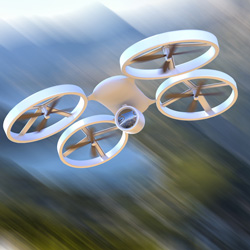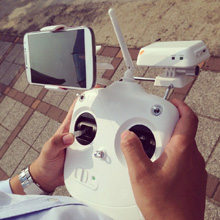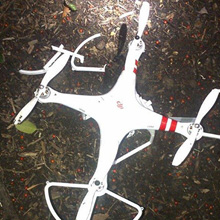 |
| Drone is a toy with a bright future—until it causes a catastrophe |
Drones, or unmanned aerial vehicles, are today’s gizmo du jour. A recent Bloomberg article reported that Amazon alone is selling more than 10,000 a month, and with prices as low as $50, it’s a toy with a bright future—until it causes a catastrophe.
Consider the January incident at the White House when a drunken National Geospatial-Intelligence Agency employee lost control of a quadcopter device and crashed it onto the southeast corner of the grounds. This kind of mishap could happen to anyone, drunk or sober, because as Tom Fuentes, CNN’s law enforcement analyst said, “They have flimsy comms systems, and it’s easy for people to lose control of them. It’s like losing the wifi signal, and the controller can’t do anything.” In this case, it is theorised that the user hadn’t set the drone’s “home point” properly so the drone got confused about its location and flew away.
There have been dozens of incidents involving close encounters with aircraft, but the FAA hasn’t yet created rules for the small crafts. The National Transportation Safety Board (NTSB), in November, formally declared that a UAV operated commercially is considered to be an aircraft under 14 C.F.R. § 91.13(a), so its operator may be subject to civil penalties for violating federal aviation regulations. However, most offenders aren’t like the partying government employee who self-reported the incident, and it’s difficult to track down users.
 |
| Drones have flimsy comms systems, and it’s easy for people to lose control of them |
Fred Roggero, former Air Force chief of safety, recently said on CNN that drones can carry “…50 lbs of stuff on some that look like an aircraft.” Obviously, 50 pounds of any sort of explosive or chemical, biological, nuclear or biological weaponry would do some serious damage.
Thus, a new industry is born—drone detection. Jamming signals is against the law in the U.S., even though it may ultimately be the best way to drop a drone in its tracks once it’s detected. Firing on one wouldn’t help because the bullets or the rocket would rain down somewhere and could harm innocents.
Boston-based HGH Infrared Systems is one drone-detection firm. It has several different models of what it calls Spynel, a camera system which goes up to a resolution of 120 megapixels. The cameras record in real time and, as the continuously spinning camera head takes an HD panoramic image of an entire area, the proprietary software automatically detects and tracks an unlimited number of targets (land, air, maritime). “Our detection range for a person on the Spynel X is up to 8 km, 15 km for a car, and up to 30 km for a tank/boat,” reports the company in an email.
 |
| Drones can carry “…50 lbs of stuff on some that look like an aircraft Photo credited: U.S. Secret Service/Reuters |
According to Katie Shea, HGH Infrared’s marketing manager, “Radars are not ideal for tracking the small, low-heat UAVs because of their low profile and low speed. Infrared sensors and Spynel work well because they are completely passive and our high-resolution infrared thermal cameras can pick up low heat deltas between ambient temperatures and the electric engine UAVs, as well as the low-speed, smaller UAVs.”
John Franklin, a Washington, D.C.-based engineer started an Indiegogo campaign and ultimately created the DroneShield™. Concerned that drones with attached cameras could easily spy on regular folks, the Indiegogo site proclaims that “DroneShield is a device that detects the presence of nearby drones (including RC helicopters, quadrotors, etc) and issues alerts via email, sms, and/or a flashing light. The goal is to help preserve your privacy from low-cost remote-control air vehicles with video cameras.”
He managed to raise more than $8,000, and now sells the devices online. Franklin’s site envisions various uses, from protecting private property to military installations and critical infrastructure.
So does competitor Drone Labs, with its Drone Detector. CEO Zain Naboulsi claims it is unlike other systems because it “…can see air, ground, and water-based threats. Auditory detection alone, for example, can typically only detect aerial drones and be easily defeated. Our technology uses multi-factor authentication to determine the confidence level of a threat. While no drone detection technology is foolproof, Drone Detector is the only detection product on the market today that is built to detect most threats regardless of where they originate.”
Now, we have to figure out a way to find out who’s doing the flying.
